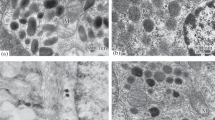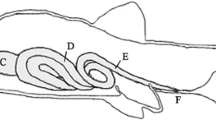Abstract
The influence of the mode of sterilization of the diet (gamma-irradiation vs. autoclaving) on the histamine and mast cells distribution in the intestinal mucosa, was studied in germ free (GF) and conventional (CV) rats. Interactions between the diet and the digestive microflora were observed. Histamine concentration and mast cells counts are higher in CV rats small intestine than in GF's. The differences are increased with the irradiated diet.
At the opposite in the hindgut, these values are higher in GF than in CV rats, especially in the rats fed the steam sterilized diet.
The variations in the wall histamine contents and in the mucosal mast cells counts due to the diet and/or the microflora do not appear to be always correlated.
Similar content being viewed by others
References
J. M. Wal, J. C. Meslin, A. Weyer and B. David,Histamine and mast cell distribution in the gastro-intestinal wall of the rat: comparison between germ-free and conventional rats. Int. Archs Allergy Appl. Immun.77, 308–314 (1985).
J. C. Meslin, E. Sacquet and M. Riottot,Effects of various modifications in the diet on ileal epithelium renewal in germfree and conventional rats. Reprod. Nutr. Develop.21, 651–659 (1981).
M. E. Coates, J. E. Ford, M. E. Gregory and S. Y. Thomson,Effects of gamma-irradiation on the vitamin content of diets for laboratory animals. Lab. Anim.3, 39–49 (1969).
R. Ferrando, J. P. Valette, L. Saint-Lebe, J. Bonnod and M. Huard,Influence de l'autoclavage ou de l'irradiation gamma sur les principaux constituants d'aliments complets composés pour rats et souris de laboratoire. Sci. Techn. Anim. Lab.6, 5–13 (1981).
D. M. Conning,Evaluation of the irradiation of animal feedstuffs. InRecent advances in food irradiation. (Eds. P. S. Elias, A. J. Cohen) pp. 247–382, Elsevier Biomedical Press, 1983.
S. Adam,Recent developments in radiation chemistry of carbohydrates. InRecent advances in food irradiation. (Eds. P. S. Elias, A. J. Cohen) pp. 149–170, Elsevier Biomedical Press, 1983.
H. Einarsson, B. G. Snygg and C. Erikson,Inhibition of bacterial growth by Maillard reaction products. J. Agric. Food Chem.31, 1043–1047 (1983).
C. Andrieux and E. Sacquet,Effects of Maillard's reaction products on apparent mineral absorption in different parts of the digestive tract. The role of microflora. Reprod. Nutr. Develop.24, 379–386 (1984).
B. Lebel,A high-sampling rate automated continuous flow fluorimetric technique for the analysis of nanogram levels of histamine in biological samples. Analyt. Biochem.133, 16–29 (1983).
L. Enerback,Mast cells in rat gastrointestinal mucosa. I. Effect of fixation. Acta Path. Microbiol. Scand.66, 289–302 (1966).
L. Enerback,Mast cells in rat gastrointestinal mucosa. II. Dye-binding and metachromatic properties. Acta Path. Microbiol. Scand.66, 303–312 (1966).
E. J. Ruitenberg, L. Gustowska, A. Elgersma and H. M. Ruitenberg,Effect of fixation on the light microscopical visualisation of mast cells in the mucosa and connective tissue of the human duodenum. Int. Archs. Allergy Appl. Immunol.67, 233–238 (1982).
G. D. Abrams,Microbial effects on mucosal structure and function. Am. J. Clin. Nutr.30, 1880–1886 (1977).
D. C. Savage,Adherence of the normal flora. InAttachement of organism to the gut mucosa. (Ed. E. C. Boedeker) pp. 3–10, CRC Press Inc., 1984.
J. P. Koopman, H. M. Kennis, J. F. M. Nouws and H. Morse,Evidence for antibacterial substance in diets for laboratory animals. Z. Versuchstierkd.28, 179–186 (1986).
A. M. Saavedra-Delgado, S. Turpin and D. D. Metcalfe,Typical and stypical mast cells of the rat gastrointestinal system: distribution and correlation with tissue histamine. Agents and Actions14, 1–7 (1984).
J. Adrian,Nutritional and physiological consequences of the Maillard reaction. World Rev. Nutr. Diet.19, 71–122 (1974).
H. H. Hiller and A. Schoen,Einfluß fehlender Darmflora auf die Verdaulichkeit einer unterschiedlich sterilisierten Ratten und Mausezuchtdiät bei Ratten. Z. Tierphysiol. Tierernährg. Futtermittelkde.28, 12–18 (1971).
G. W. Read, S. M. Hong and E. F. Kiefer,Competitive inhibition of 48/80-induced histamine release by bensalkonium chloride and its analogs and the polyamine receptor in mast cells. J. Pharmacol. Exp. Ther.222, 652–657 (1982).
P. H. Scheuber, C. Denzlinger, D. Wilker, G. Beck, D. Kepler and D. K. Hammer,Staphylococcal enterotoxin B as a nonimmunological mast cell stimulus in primates: the role of endogenous cysteinyl leukotrienes. Int. Arch Allergy Appl. Immun.82, 289–291 (1987).
S. Norn, P. S. Skov, C. Jensen, J. O. Jarlov and J. Espersen,Histamine release induced by bacteria. A new mechanism in asthma? Agents and Actions20, 29–34 (1987).
S. Norn, J. O. Jarlov, C. B. Jensen, P. Clementsen, B. T. Dahl, F. Esperson and P. S. Skov,Bacteria and their products peptidoglycan and teichoic acid potentiate antigen-induced histamine release in allergic patients. Agents and Actions20, 174–177 (1987).
M. K. Church, S. Norn, G. J. K. Pao and S. T. Holgate,Non-IgE-dependent bacteria-induced histamine release from human lung and tonsillar mast cells. Clin. Allergy17, 341–353 (1987).
Z. Horakova, C. H. Zierdt and M. A. Beaven,Identification of Lactobacillus as the source of bacterial histidine decarboxylase in rat stomach. Eur. J. Pharmacol.16, 67–77 (1971).
J. Y. Huy and S. L. Taylor,Inhibition of in vivo histamine metabolism in rats by foodborne and pharmacologic inhibitors of diamine oxydase, histamine N-methyl-transferase, and monoamine oxydase, Toxicol. Appl. Pharmacol.81, 241–249 (1985).
J. Kusche, R. Menningen, L. Leisten and B. Amoei,Elevation of the large bowel histamine concentration by aminoguanidine induced diamine oxidase inhibition. Agents and Actions20, 274–276 (1987).
J. P. Koopman, A. M. Stradhouders, H. M. Kennis and H. De Boer,The attachment of filamentous segmented micro-organisms to the distal ileum of the mouse: a scanning and transmission electron microscopy study. Lab. Anim.21, 48–52 (1987).
Author information
Authors and Affiliations
Rights and permissions
About this article
Cite this article
Meslin, J.C., Wal, J.M. & Rochet, V. Histamine and mast cell distribution in the intestinal wall of the germ free and conventional rats. Influence of the mode of sterilization of the diet. Agents and Actions 29, 131–137 (1990). https://doi.org/10.1007/BF01966437
Received:
Accepted:
Issue Date:
DOI: https://doi.org/10.1007/BF01966437




